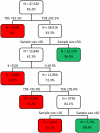Novel insights in the fecal egg count reduction test for monitoring drug efficacy against soil-transmitted helminths in large-scale treatment programs
- PMID: 22180801
- PMCID: PMC3236725
- DOI: 10.1371/journal.pntd.0001427
Novel insights in the fecal egg count reduction test for monitoring drug efficacy against soil-transmitted helminths in large-scale treatment programs
Abstract
Background: The fecal egg count reduction test (FECRT) is recommended to monitor drug efficacy against soil-transmitted helminths (STHs) in public health. However, the impact of factors inherent to study design (sample size and detection limit of the fecal egg count (FEC) method) and host-parasite interactions (mean baseline FEC and aggregation of FEC across host population) on the reliability of FECRT is poorly understood.
Methodology/principal findings: A simulation study was performed in which FECRT was assessed under varying conditions of the aforementioned factors. Classification trees were built to explore critical values for these factors required to obtain conclusive FECRT results. The outcome of this analysis was subsequently validated on five efficacy trials across Africa, Asia, and Latin America. Unsatisfactory (<85.0%) sensitivity and specificity results to detect reduced efficacy were found if sample sizes were small (<10) or if sample sizes were moderate (10-49) combined with highly aggregated FEC (k<0.25). FECRT remained inconclusive under any evaluated condition for drug efficacies ranging from 87.5% to 92.5% for a reduced-efficacy-threshold of 90% and from 92.5% to 97.5% for a threshold of 95%. The most discriminatory study design required 200 subjects independent of STH status (including subjects who are not excreting eggs). For this sample size, the detection limit of the FEC method and the level of aggregation of the FEC did not affect the interpretation of the FECRT. Only for a threshold of 90%, mean baseline FEC <150 eggs per gram of stool led to a reduced discriminatory power.
Conclusions/significance: This study confirms that the interpretation of FECRT is affected by a complex interplay of factors inherent to both study design and host-parasite interactions. The results also highlight that revision of the current World Health Organization guidelines to monitor drug efficacy is indicated. We, therefore, propose novel guidelines to support future monitoring programs.
Conflict of interest statement
The authors have declared that no competing interests exist.
Figures



Similar articles
-
Novel insights in the faecal egg count reduction test for monitoring drug efficacy against gastrointestinal nematodes of veterinary importance.Vet Parasitol. 2012 Sep 10;188(3-4):391-6. doi: 10.1016/j.vetpar.2012.03.020. Epub 2012 Mar 20. Vet Parasitol. 2012. PMID: 22521979
-
The bias, accuracy and precision of faecal egg count reduction test results in cattle using McMaster, Cornell-Wisconsin and FLOTAC egg counting methods.Vet Parasitol. 2012 Aug 13;188(1-2):194-9. doi: 10.1016/j.vetpar.2012.03.017. Epub 2012 Mar 20. Vet Parasitol. 2012. PMID: 22503038
-
Comparison of the Kato-Katz thick smear and McMaster egg counting techniques for monitoring drug efficacy against soil-transmitted helminths in schoolchildren on Pemba Island, Tanzania.Trans R Soc Trop Med Hyg. 2012 Mar;106(3):199-201. doi: 10.1016/j.trstmh.2011.11.006. Epub 2012 Jan 18. Trans R Soc Trop Med Hyg. 2012. PMID: 22261186
-
World Association for the Advancement of Veterinary Parasitology (W.A.A.V.P.) guideline for diagnosing anthelmintic resistance using the faecal egg count reduction test in ruminants, horses and swine.Vet Parasitol. 2023 Jun;318:109936. doi: 10.1016/j.vetpar.2023.109936. Epub 2023 Apr 23. Vet Parasitol. 2023. PMID: 37121092 Review.
-
Confounding factors affecting faecal egg count reduction as a measure of anthelmintic efficacy.Parasite. 2022;29:20. doi: 10.1051/parasite/2022017. Epub 2022 Apr 7. Parasite. 2022. PMID: 35389336 Free PMC article. Review.
Cited by
-
Use of quantitative PCR to assess the efficacy of albendazole against Necator americanus and Ascaris spp. in Manufahi District, Timor-Leste.Parasit Vectors. 2018 Jun 28;11(1):373. doi: 10.1186/s13071-018-2838-0. Parasit Vectors. 2018. PMID: 29954461 Free PMC article.
-
Vaccination of human participants with attenuated Necator americanus hookworm larvae and human challenge in Australia: a dose-finding study and randomised, placebo-controlled, phase 1 trial.Lancet Infect Dis. 2021 Dec;21(12):1725-1736. doi: 10.1016/S1473-3099(21)00153-5. Epub 2021 Aug 19. Lancet Infect Dis. 2021. PMID: 34419209 Free PMC article. Clinical Trial.
-
A general framework to support cost-efficient fecal egg count methods and study design choices for large-scale STH deworming programs-monitoring of therapeutic drug efficacy as a case study.PLoS Negl Trop Dis. 2023 May 17;17(5):e0011071. doi: 10.1371/journal.pntd.0011071. eCollection 2023 May. PLoS Negl Trop Dis. 2023. PMID: 37196017 Free PMC article. Clinical Trial.
-
Comparison of individual and pooled stool samples for the assessment of soil-transmitted helminth infection intensity and drug efficacy.PLoS Negl Trop Dis. 2013 May 16;7(5):e2189. doi: 10.1371/journal.pntd.0002189. Print 2013. PLoS Negl Trop Dis. 2013. PMID: 23696905 Free PMC article.
-
Application of a Poisson distribution quality control measure to the analysis of two human hookworm drug treatment studies in Ghana.Int J Parasitol Drugs Drug Resist. 2014 Jan 31;4(1):64-70. doi: 10.1016/j.ijpddr.2014.01.001. eCollection 2014 Apr. Int J Parasitol Drugs Drug Resist. 2014. PMID: 24596670 Free PMC article.
References
-
- Bethony J, Brooker S, Albonico M, Geiger SM, Loukas A, et al. Soil-transmitted helminth infections: ascariasis, trichuriasis, and hookworm. Lancet. 2006;367:1521–1532. - PubMed
-
- WHO. Deworming for health and development. 2005. Report of the third global meeting of the Partners for Parasitic Control. WHO/CDS/CPE/PVC/2005.14, World Health Organization, Geneva.
-
- Albonico M, Engels D, Savioli L. Monitoring drug efficacy and early detection of drug resistance in human soil-transmitted nematodes: a pressing public health agenda for helminth control. Int J Parasitol. 2004;34:1205–1210. - PubMed
-
- Geerts S, Gryseels B. Anthelmintic resistance in human helminths: a review. Trop Med Int Health. 2001;6:915–921. - PubMed
-
- De Clercq D, Sacko M, Behnke JM, Gilbert F, Dorny P, et al. Failure of mebendazole in treatment of human hookworm infections in the Southern Region of Mali. Am J Trop Med Hyg. 1997;57:25–30. - PubMed
Publication types
MeSH terms
Substances
LinkOut - more resources
Full Text Sources
Medical

